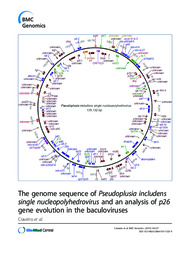The genome sequence of Pseudoplusia includes single nucleopolyhedrovirus and an analysis of p26 gene evolution in the baculoviruses.
The genome sequence of Pseudoplusia includes single nucleopolyhedrovirus and an analysis of p26 gene evolution in the baculoviruses.
Author(s): CRAVEIRO, S. R.; TOGAWA, R. C.; INGLIS, P. W.; GRYNBERG, P.; MELO, F. L.; RIBEIRO, Z. M. de A.; RIBEIRO, B. M.; BÁO, S. N.; CASTRO, M. E. B. de
Summary: Background: Pseudoplusia includens single nucleopolyhedrovirus (PsinSNPV-IE) is a baculovirus recently identified in our laboratory, with high pathogenicity to the soybean looper, Chrysodeixis includens (Lepidoptera: Noctuidae) (Walker, 1858). In Brazil, the C. includens caterpillar is an emerging pest and has caused significant losses in soybean and cotton crops. The PsinSNPV genome was determined and the phylogeny of the p26 gene within the family Baculoviridae was investigated. Results: The complete genome of PsinSNPV was sequenced (Roche 454 GS FLX ? Titanium platform), annotated and compared with other Alphabaculoviruses, displaying a genome apparently different from other baculoviruses so far sequenced. The circular double-stranded DNA genome is 139,132 bp in length, with a GC content of 39.3 % and contains 141 open reading frames (ORFs). PsinSNPV possesses the 37 conserved baculovirus core genes, 102 genes found in other baculoviruses and 2 unique ORFs. Two baculovirus repeat ORFs (bro) homologs, bro-a (Psin33) and bro-b (Psin69), were identified and compared with Chrysodeixis chalcites nucleopolyhedrovirus (ChchNPV) and Trichoplusia ni single nucleopolyhedrovirus (TnSNPV) bro genes and showed high similarity, suggesting that these genes may be derived from an ancestor common to these viruses. The homologous repeats (hrs) are absent from the PsinSNPV genome, which is also the case in ChchNPV and TnSNPV. Two p26 gene homologs (p26a and p26b) were found in the PsinSNPV genome. P26 is thought to be required for optimal virion occlusion in the occlusion bodies (OBs), but its function is not well characterized. The P26 phylogenetic tree suggests that this gene was obtained from three independent acquisition events within the Baculoviridae family. The presence of a signal peptide only in the PsinSNPV p26a/ORF-20 homolog indicates distinct function between the two P26 proteins. Conclusions: PsinSNPV has a genomic sequence apparently different from other baculoviruses sequenced so far. The complete genome sequence of PsinSNPV will provide a valuable resource, contributing to studies on its molecular biology and functional genomics, and will promote the development of this virus as an effective bioinsecticide.
Publication year: 2015
Types of publication: Journal article
Keywords: Baculovirus, Insiticida biológico, Praga, Pseudoplusia Includens
Observation
Some of Embrapa's publications are published as ePub files. To read them, use or download one of the following free software options to your computer or mobile device. Android: Google Play Books; IOS: iBooks; Windows and Linux: Calibre.
Access other publications
Access the Agricultural Research Database (BDPA) to consult Embrapa's full library collection and records.
Visit Embrapa Bookstore to purchase books and other publications sold by Embrapa.

